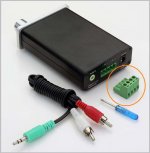Looking for this connector that speaker wires screw into and plugs into this amp. If it is proprietary I am screwed but if it is a Molex std or something some search terms would help. I cannot begin to find it in the incomprehensible and truly awful online digi-Key catalog. Thank you.
Greg
Greg
Attachments
I doubt it's proprietary. You'll need to look under a category at Digi-Key like "Terminal Blocks - Headers, Plugs and Sockets" for 4 conductors and proper dimensions. I don't know the proper technical or trade name for what you have there.
Very kool. The four fingers that insert into the amp have a square top and round underside as the one I need. But the underside is convex as opposed to the concave underside of this model. This is confirmed when I look at the mating component that mounts on the PCB for the connector you have found. Very similar but the curves are opposite to what I need. You have given me the tools to proceed though. Thank you!
http://rhu004.sma-promail.com/SQLImages/kelmscott/Molex/PDF_Images/usa-355.PDF
I think what I have is either the 5.00mm (.197") Pitch or 5.08mm(.200") Pitch ESE Pluggable Terminal Blocks.
I will have to get one in my hands I think... I wonder if my local commercial electronics supplier have these? I doubt it ...
I think what I have is either the 5.00mm (.197") Pitch or 5.08mm(.200") Pitch ESE Pluggable Terminal Blocks.
I will have to get one in my hands I think... I wonder if my local commercial electronics supplier have these? I doubt it ...
The difference in pitch may not arise if you only have a couple pins, the more pins on the connector, the longer it is, and the more chance all those 0.08mm differences will add up to a problem. But it is only 0.08mm, a tiny amount.
pheonix started off the Combicon range, there are numerous different makes from other manufacturers. But some combinations of plug and socket from different manufacturers dont always mate securely. The actual Phoenix and Eletro Gibbi have provided the best quality and mating (used to buy them in the 100,000nds). Some cheeper makes will only mate with them selves and may not always pass vibration tests...
Up to about 6 pins the 5.00 and 5.08 will mate with a bit of force.
The above named makes will all fit in a PCB hole of 1.3mm, some other makes require a 1.4mm PCB hole, to cater for all makes I extend the outer holes spaceing so that there is a slight friction fit when putting the connectors in the board, possibly not required for hand soldering, but when using wave or selective soldering they can bounce out of the board.
Up to about 6 pins the 5.00 and 5.08 will mate with a bit of force.
The above named makes will all fit in a PCB hole of 1.3mm, some other makes require a 1.4mm PCB hole, to cater for all makes I extend the outer holes spaceing so that there is a slight friction fit when putting the connectors in the board, possibly not required for hand soldering, but when using wave or selective soldering they can bounce out of the board.
Last edited:
- Status
- Not open for further replies.
- Home
- Design & Build
- Parts
- What is this and where can I find one
